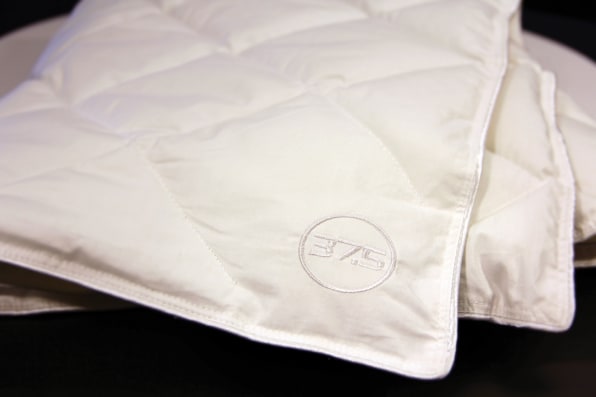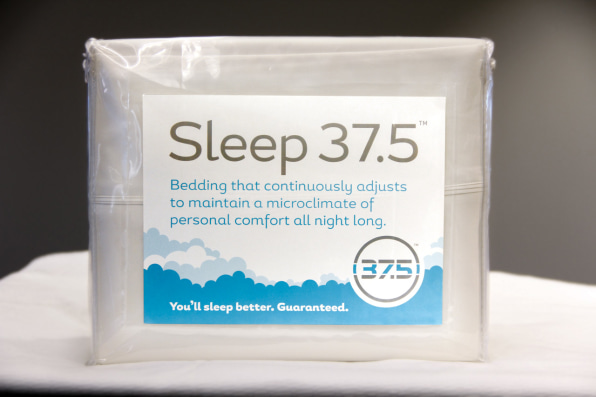Better Homes And Gardens Embroidered Luxury Microfiber Sheet Set
Americans sleep an average seven hours and 36 minutes every night. Forty-five percent say that poor or insufficient sleep affects their daily activities at least once a week, according to a December 2014 report by the National Sleep Foundation.
Of course, there are many things one can do to improve sleep. Keep the room dark. Go to bed and wake up at the same time every day. Take a pill.

But what if a fresh set of sheets could greatly improve slumber without the effort–or prescription–those other methods require? That's what the makers of the 37.5 bedding system promise.
Introduced in 2014 and currently sold at mass retailers including Bed, Bath & Beyond and QVC, 37.5's proprietors claim that this sheet-and-comforter set works by managing your personal microclimate. The Boulder, Colo.-based company, founded in 2006 by former government scientist Dr. Gregory Haggquist, has been licensing 37.5 fabric to makers of activewear such as Adidas, the North Face, and Under Armour, for years. But bedding marks the first time 37.5 is selling its own product, betting big on its namesake brand, with retail sales expected to reach $5 to $6 million in 2015.

It can be difficult to grasp the magic behind 37.5, but Haggquist did an admirable job of explaining it the nuances of its design. "Most [fabric] is passive, it doesn't know what your body wants," he says. This stuff, on the other hand, contains active particles–naturally occurring minerals–that are incorporated into the fabric via a patented, top-secret method. While a lot of performance fabrics wick away sweat, 37.5 turns excess heat and moisture into a vapor. The fabric dries quickly, helping to regulate your body's temperature. If you're shivering, it does the opposite, holding in heat to bring you back to a normal body temperature. (The team says that a run through the washing machine will restore the fabric to its original effectiveness.)
37.5 says that using its entire bedding system–sheets, mattress covers, pillowcases, duvet, et.al–will help you sleep better, ushering in all the benefits of a proper rest: from clearer thinking to improved mood. Just using the sheets on their own will even do some good. (In a third-party field test done with sheets-only, 100% of users woke up fewer times.)
In a third-party field test done with sheets-only, 100% of users woke up fewer times.
The company has commissioned multiple independent studies to measure the product's merit. The Swiss Federal Laboratories for Materials Science and Technology, also known as EMPA, found that using a 37.5 comforter reduced humidity within the sleeper's microclimate. (Too much or too little humidity can make you too hot or too cold.) Another study, conducted by German company NetConsult, also suggests that 37.5 is better at regulating humidity than a traditional comforter and sheets.
But what does that all mean to an actual, sleeping human? I conducted a study of my own, albeit unscientific, over the course of two weeks using the 37.5 bedding system in its entirety. I took my temperature each night and every morning, and also took notes on how hot or cold, comfortable or uncomfortable, I was feeling.
Other than learning that my temperature naturally runs a bit lower than 98.6 degrees fahrenheit–which is 37.5 degrees when converted to celsius (get it?)–I didn't have any big revelation when I switched to the system. I did, however, feel a little less sweaty in the morning. And I was definitely more comfortable. One of 37.5's big promises is that you won't feel the urge to kick the sheets off in the middle of the night, and that's accurate. In fact, just using the sheet on its own was often enough for me, which is definitely not true with traditional bedding. My husband, who "runs warm," did not monitor his temperature, although he did like using the set.
"I'm not in a position to say that it's better or worse, but I appreciate a cool set of sheets and pillowcases," he pointed out. "These are reliably cool."
One other notable plus: there is no weird smell, which is something often associated with technical fabrics. As far as sleeping better goes, neither my husband nor I have any particular trouble sleeping, so I'm not sure how much more helpful 37.5 would be to someone suffering from some sort of sleeping disorder.
"Existing bedding [brands] are telling the same old stories," says Bowman
Am convinced that 37.5 improved my life? It may be placebo effect, but . . . it's possible. What I do know for sure: It feels better than any set I've ever used, and for me, that's enough of a value proposition. After all, there really isn't anything else out there wowing me. And that's exactly what 37.5 is capitalizing on, as its offerings don't come cheap: Depending on what you want, prices range from $50-$250.
"Existing bedding [brands] are telling the same old stories," says Bowman, referring to the industry's obsession with thread count, even though experts concur that a high thread count does not equal a good product. "One of our challenges–and opportunities–is to redefine what high-quality bedding means." All in the name of a good night's sleep.
Better Homes And Gardens Embroidered Luxury Microfiber Sheet Set
Source: https://www.fastcompany.com/3041732/will-a-set-of-sheets-make-you-sleep-better
Posted by: floressirche.blogspot.com

0 Response to "Better Homes And Gardens Embroidered Luxury Microfiber Sheet Set"
Post a Comment